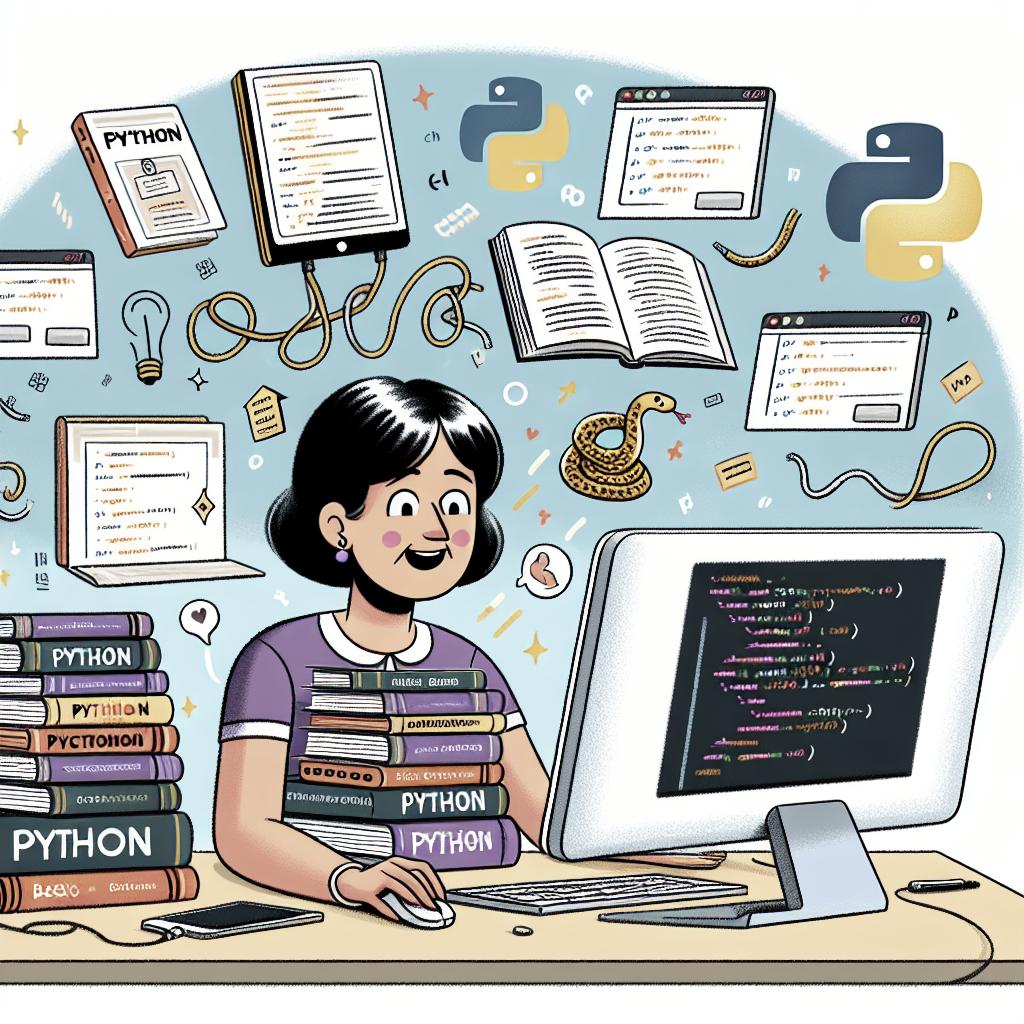“`html
Best Practices for Remote Coding Interviews
In today’s fast-paced digital world, remote coding interviews have become a staple for scouting tech talent across the globe. To ace these interviews, it’s essential to not only have sharp coding skills but also be well-prepared for the unique challenges they present. From selecting the right programming language to mastering key concepts like data structures and algorithms, this article will guide you through the best practices for excelling in remote coding interviews. We will walk you through each step of the preparation process, break down what to expect during the interview, and share practical tips and strategies. By the end, you’ll be equipped with the tools to confidently tackle any coding challenge that comes your way.
Picking a programming language
One of the first decisions you’ll face when preparing for a coding interview is selecting a programming language. It’s crucial to choose a language you’re comfortable with, as familiarity will allow you to focus on problem-solving rather than syntax. Popular choices include Python for its readability, Java for its extensive libraries, and C++ for its performance benefits. Understand the trade-offs of each language and how they fit with the typical questions you might encounter.
Additionally, the chosen language should be one that can efficiently solve a wide array of data structure and algorithm problems. While it’s beneficial to know multiple languages, achieving proficiency in one at depth will allow you to express complex ideas fluently during your interview.
Review your CS101
Before heading into a remote coding interview, revisiting basic computer science concepts is invaluable. Brush up on fundamentals such as data structures including arrays, linked lists, stacks, and queues, and understand how they function. These foundations are often the starting point for segmenting larger problems into manageable solutions.
Moreover, refresh your understanding of time and space complexity. Being able to analyze and communicate the efficiency of your solutions is often as important as finding the correct answer. Interviewers appreciate candidates who demonstrate a clear understanding of Big O notation.
Mastery through practice
There’s no substitute for hands-on practice when preparing for coding interviews. Platforms like LeetCode, HackerRank, and CodeSignal provide a plethora of problems that can help sharpen your skills. Start with easy-level problems to gain confidence and gradually work your way up to more challenging questions.
Consistent practice not only enhances problem-solving skills but also improves speed and accuracy, which are critical during timed interviews. Aim to make practice a daily habit to effectively reinforce learning and pattern recognition.
Phases of a coding interview
A typical coding interview is structured into several phases, each designed to assess different skills. They usually begin with a problem statement followed by discussing potential solutions, coding, and then testing. Understanding the flow can help alleviate anxiety and allow you to better manage your time and responses.
Engage actively in each phase; for instance, clarify doubts in the problem statement phase and explain your thought process during the discussion phase. Transparency in your approach not only helps build rapport with the interviewer but also shows that you’re methodical and logical.
Preparing for a remote interview
Remote interviews come with their own set of challenges, such as technical issues and communication barriers. Before your interview, ensure your home setup is optimal with a reliable internet connection and a quiet environment. Test your webcam and microphone to ensure they work adequately.
It’s also helpful to familiarize yourself with the interviewing platform, whether it’s Zoom, Microsoft Teams, or a specialized code-sharing tool. Practice coding with a simple text editor to mimic the real-world constraints of a whiteboard interview.
What to do when you get the question
Upon receiving a question, take a moment to comprehend it thoroughly before jumping into code. Ask clarifying questions to remove any ambiguity and ensure you grasp the problem’s requirements and constraints. Visualize the problem with examples and edge cases to better formulate your approach.
Your initial focus should be on devising a logical plan. Articulate your strategy to the interviewer, breaking down how you intend to tackle the problem. This not only keeps them engaged but also leaves room for feedback or hints.
Starting to code
When you begin coding, stay calm and adhere closely to the plan you’ve laid out. Pay attention to code readability as much as functionality—clear and well-structured code tends to leave a stronger impression. Use meaningful variable names and include comments to describe complex logic.
Since remote environments might use interfaces with limited features, be mindful of common pitfalls like syntax errors. Implement quick checks at different stages to ensure your logic is sound, preventing accumulation of errors that may become harder to debug later.
After coding
Once your code is complete, resist the urge to move on instantly. Reviewing your solution is critical. Check for typos, syntax errors, and off-by-one errors, which are common and can affect the outcome significantly. Run through some test cases, including edge cases, to validate your implementation.
Be open to discussing improvements, whether optimizing time complexity or refactoring code for better readability. Being receptive and adaptive to feedback reflects on your growth mindset and willingness to learn.
Practice with mock interviews
Mock interviews are a powerful tool in preparing for the real thing. They simulate the stress and constraints of an actual interview and provide valuable feedback. You can arrange mocks with a peer or use online services where professionals can critique your approach and execution.
Through consistent practice, you’ll not only gain confidence but also uncover areas of improvement. Pay attention to recurring mistakes or gaps in your knowledge and address them systematically.
Go forth and conquer
A successful remote coding interview is a culmination of many elements: technical skills, clear communication, and the right mindset. By following the above practices diligently, you’ll be well-equipped to handle the challenges that come your way.
Working towards mastery may be demanding, but persistence is key. Keep yourself motivated and remember that each interview is a learning opportunity, irrespective of the outcome.
Practical tips for coding questions
Approaching coding questions with practical strategies can greatly improve your performance. Always start with a brute-force solution to establish a baseline, then look for optimizations. Break problems into smaller, manageable parts to simplify your approach.
Look for patterns and familiar paradigms within the question. Often, problems share underlying structures, and recognizing them can lead to quicker, more efficient solutions.
General tips
The general tips section aims to arm you with broader strategies that transcend specific problem types. Time management is crucial—allocate your time wisely across understanding the question, coding, and testing. Communication is another key component—constantly verbalize your thought process to keep the interviewer engaged.
Ensure you’re well-rested before every interview. Physical and mental well-being directly impact performance, so take care of your health during the preparation phase.
Sequence
Sequence problems often revolve around predicting or extrapolating elements based on the given pattern. They test your ability to recognize order or series. Focus on understanding arithmetic and geometric series, along with their properties.
Practice developing algorithms that can detect and continue sequences, leveraging loops and mathematical functions to handle different complexities that might arise.
Array
Array problems are a staple in coding interviews, testing your comfort with looping mechanisms and indexing. They often require you to manipulate elements, traverse them efficiently, or maintain order with specific conditions.
The key to mastering array questions lies in practicing a diverse set of problems that involve searching, sorting, and transforming operations. Familiarize yourself with common algorithms like merge and quicksort which appear in various array problems.
Binary
Binary problems challenge your understanding of low-level computing processes. Whether it’s bit manipulation or numerical conversions, binary-related questions assess your knowledge of how data is represented and manipulated at a fundamental level.
Brush up on basic binary operations like shifts, logical AND, OR, and XOR. These can often lead to optimized solutions where traditional approaches might fall short.
Dynamic Programming
Dynamic Programming (DP) is an advanced technique used to optimize recursive algorithms by storing interim results. It’s typically used for optimization problems where decision-making over intersections is required.
To excel at DP, understand how to decompose problems into overlapping subproblems. Practice with classic problems like the knapsack problem, Fibonacci sequence, and longest increasing subsequence.
Geometry
Geometry problems in coding interviews assess spatial reasoning and the ability to work with graphical data. You might be asked to calculate distances, angles, or areas, often under certain constraints.
Strengthen your skills by revisiting geometry concepts and applying them in coding contexts. Problems often involve coordinate geometry, so practice calculating and interpreting distances and intersections.
Graph
Graph theory is a cornerstone of computer science, playing a pivotal role in solving problems like network routing or social network analysis. Graph problems involve understanding nodes and edges and using algorithms like BFS or DFS to traverse or find the shortest paths.
Delve into various graph representations, such as adjacency matrices and lists, and practice applying algorithms to real-world scenarios for a solid grasp of their utility and implementation.
Interval
Interval problems often deal with ranges and overlap among different datasets. They require you to analyze how intervals interact or change over time, such as scheduling problems.
Familiarize yourself with techniques for sorting and manually comparing intervals. Efficient solutions may involve interval trees or other advanced data structures that facilitate faster queries and modifications.
Linked List
Linked Lists are essential linear structures that help understand dynamic data manipulation. Common problems might involve reversing lists, detecting cycles, or merging sorted lists.
Practice pointer manipulation skills, as these are crucial for modifying list structures in place and effectively gaining insights into performance considerations of operations on linked lists.
Math
Math-related coding problems test your ability to employ mathematical logic and formulas. They’re typically algorithmic in nature, styling solutions that require numeric calculations or optimizations.
Strengthen your arithmetic, algebra, and number theory skills, which frequently appear in scenarios such as factorization, prime identification, and modular arithmetic in coding challenges.
Matrix
Matrix problems often require knowledge of multi-dimensional arrays and their manipulation. They’re a common staple in graphical computations or scientific problem sets.
Practice transposing, rotating, and flattening matrices. Familiarize yourself with typical matrix operations and scenarios, like determinants or inverses, which may occasionally pop up in interviews.
Recursion
Recursion problems focus on building solutions using repetitive, self-solving function calls. These problems are designed to examine your ability to think recursively and employ stack-based solutions efficiently.
Familiarize yourself with recursive fundamentals and typical issues like stack overflow and hitting base cases. Also, practice converting solutions to iterative forms for better understanding and optimization.
String
String manipulation questions test your dexterity with character arrays and often involve parsing or modifying textual data. Problems might include reversing strings, checking palindromes, or converting cases.
Get comfortable using language-specific string functions and employ common algorithmic strategies like two-pointer technique, hashing, or dynamic programming for pattern matching in strings.
Tree
Tree data structures represent hierarchical data efficiently and are crucial in understanding connections and branches within problem sets. Problems often involve traversals or balancing and modifying trees to fit specific constraints.
Gain proficiency in standard traversal techniques—like in-order, pre-order, and post-order—ensure clarity in constructing and deconstructing trees for a balanced approach to solving tree-related challenges.
Binary tree
Binary Trees present a simplified tree structure with each node having at most two children. These problems explore relationships and paths within the nodes and include finding levels or subtree symmetries.
Mastering binary tree problems usually involves recursive methods or employing queues for iterative solutions. Practice problems involving counting nodes, tree height, and all-paths summation.
Binary search tree (BST)
BST problems rely on the ordered property of binary search trees, where each node’s left child is lesser, and the right child is greater. Such problems revolve around search efficiency and tree operations like insertions and deletions.
Your focus should be on leveraging the properties of BSTs to optimize search operations. Practice understanding cases that might require rotations or rebalancing to maintain the BST properties.
Tries
Tries, or prefix trees, effectively store dynamic datasets like dictionaries, offering quick retrieval based on prefixes. They are frequently used in string-related search problems.
To excel with tries, invest in understanding their node-based structure and operations such as insertion, deletion, and prefix searching. Practice use-cases involving autocomplete systems or spell-check functionalities.
Heap
Heaps are specialized tree-based structures that enable priority queue operations like finding maximum or minimum efficiently. Heap-based problems often involve real-time optimizations or resource allocations.
Familiarize yourself with both max-heaps and min-heaps and their implementations through arrays or explicit trees. Practice applications including building heaps and using heaps for sort or acquisition problems.
Next steps
| Concept | Description | Key Focus |
|---|---|---|
| Picking a programming language | Select a comfortable language for coding interviews | Familiarity and efficiency |
| Review your CS101 | Brush up on essential computer science concepts | Data structures, complexity |
| Mastery through practice | Engage in regular coding practice | Platforms like LeetCode, timed practice |
| Phases of a coding interview | Understand typical interview segments | Problem comprehension, coding, testing |
| Preparing for a remote interview | Optimize technical setup and overcome remote challenges | Connectivity, familiarity with platforms |
| What to do when you get the question | Approach initial problem comprehension methodically | Clarifying, strategizing |
| Starting to code | Begin coding with clarity and structure | Readability, error-checking |
| After coding | Review and test code with thoroughness | Debugging, validation |
| Practice with mock interviews | Simulate real interview experiences | Feedback, stress management |
| Go forth and conquer | Employ learnt practices in interviews | Persistence, learning mindset |
| Practical tips for coding questions | Strategize efficiently to solve coding challenges | Patterns, optimizations |
| General tips | Adopt universal strategies during interviews | Time management, communication |
| Specific Topics | Deep dive into technical topics like arrays, graphs, etc. | Problem-solving, concept grounding |
“`


